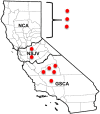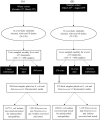Epidemiology of antimicrobial resistance (AMR) on California dairies: descriptive and cluster analyses of AMR phenotype of fecal commensal bacteria isolated from adult cows
- PMID: 33976962
- PMCID: PMC8063881
- DOI: 10.7717/peerj.11108
Epidemiology of antimicrobial resistance (AMR) on California dairies: descriptive and cluster analyses of AMR phenotype of fecal commensal bacteria isolated from adult cows
Abstract
Background: This study describes the occurrence of antimicrobial resistance (AMR) in commensal Escherichia coli and Enterococcus/Streptococcus spp. (ES) isolated from fecal samples of dairy cows and assesses the variation of AMR profiles across regions and seasons following the implementation of the Food and Agricultural Code (FAC) Sections 14400-14408 (formerly known as Senate Bill, SB 27) in California (CA).
Methods: The study was conducted on ten dairies distributed across CA's three milk sheds: Northern California (NCA), Northern San Joaquin Valley (NSJV), and the Greater Southern California (GSCA). On each study dairy, individual fecal samples were collected from two cohorts of lactating dairy cows during the fall/winter 2018 and spring/summer 2019 seasons. Each cohort comprised of 12 cows per dairy. The fecal samples were collected at enrollment before calving (close-up stage) and then monthly thereafter for four consecutive time points up to 120 days in milk. A total of 2,171 E. coli and 2,158 ES isolates were tested for antimicrobial susceptibility using the broth microdilution method against a select panel of antimicrobials.
Results: The E. coli isolates showed high resistance to florfenicol (83.31% ± 0.80) and sulphadimethoxine (32.45%), while resistance to ampicillin (1.10% ± 0.21), ceftiofur (1.93% ± 0.29), danofloxacin (4.01% ± 0.42), enrofloxacin (3.31% ± 0.38), gentamicin (0.32% ± 0.12) and neomycin (1.61% ± 0.27) had low resistance proportions. The ES isolates were highly resistant to tildipirosin (50.18% ± 1.10), tilmicosin (48% ± 1.10), tiamulin (42%) and florfenicol (46% ± 1.10), but were minimally resistant to ampicillin (0.23%) and penicillin (0.20%). Multidrug resistance (MDR) (resistance to at least 1 drug in ≥3 antimicrobial classes) was observed in 14.14% of E. coli isolates and 39% of ES isolates. Escherichia coli isolates recovered during winter showed higher MDR prevalence compared to summer isolates (20.33% vs. 8.04%). A higher prevalence of MDR was observed in NSJV (17.29%) and GSCA (15.34%) compared with NCA (10.10%).
Conclusions: Our findings showed high rates of AMR to several drugs that are not labeled for use in lactating dairy cattle 20 months of age or older. Conversely, very low resistance was observed for drugs labeled for use in adult dairy cows, such as cephalosporins and penicillin. Overall, our findings identified important differences in AMR by antimicrobial class, region and season.
Keywords: Antimicrobial resistance; California; Cohort study; Dairy cattle; Enterococcus spp; Escherichia coli; Multidrug resistance; Phenotype; Region; Season.
© 2021 Abdelfattah et al.
Conflict of interest statement
Sharif Aly is an Academic Editor for PeerJ.
Figures








Similar articles
-
Antimicrobial drug use and its association with antimicrobial resistance in fecal commensals from cows on California dairies.Front Vet Sci. 2025 Feb 10;11:1504640. doi: 10.3389/fvets.2024.1504640. eCollection 2024. Front Vet Sci. 2025. PMID: 39996264 Free PMC article.
-
Association between herd management practices and antimicrobial resistance in Salmonella spp. from cull dairy cattle in Central California.PeerJ. 2019 Mar 21;7:e6546. doi: 10.7717/peerj.6546. eCollection 2019. PeerJ. 2019. PMID: 30923650 Free PMC article.
-
2018 Survey of antimicrobial drug use and stewardship practices in adult cows on California dairies: post-Senate Bill 27.PeerJ. 2021 Jul 13;9:e11515. doi: 10.7717/peerj.11515. eCollection 2021. PeerJ. 2021. PMID: 34306824 Free PMC article.
-
Antimicrobial Resistance in Fecal Escherichia coli and Salmonella enterica from Dairy Calves: A Systematic Review.Foodborne Pathog Dis. 2019 Jan;16(1):23-34. doi: 10.1089/fpd.2018.2529. Epub 2018 Nov 27. Foodborne Pathog Dis. 2019. PMID: 30481058
-
A scoping review of antimicrobial resistance in the Australian dairy cattle industry.Prev Vet Med. 2024 May;226:106161. doi: 10.1016/j.prevetmed.2024.106161. Epub 2024 Feb 24. Prev Vet Med. 2024. PMID: 38460345
Cited by
-
Evaluation of antimicrobial resistance and risk factors for recovery of intrauterine Escherichia coli from cows with metritis on California commercial dairy farms.Sci Rep. 2022 Aug 17;12(1):13937. doi: 10.1038/s41598-022-18347-w. Sci Rep. 2022. PMID: 35978077 Free PMC article.
-
Effects of age and pasture type on the concentration and prevalence of tetracycline and macrolide resistant Enterococcus species in beef cow-calf production system.Front Antibiot. 2022 Nov 3;1:1052316. doi: 10.3389/frabi.2022.1052316. eCollection 2022. Front Antibiot. 2022. PMID: 39816401 Free PMC article.
-
Salmon-IgM Functionalized-PLGA Nanosystem for Florfenicol Delivery as an Antimicrobial Strategy against Piscirickettsia salmonis.Nanomaterials (Basel). 2024 Oct 16;14(20):1658. doi: 10.3390/nano14201658. Nanomaterials (Basel). 2024. PMID: 39452994 Free PMC article.
-
Antimicrobial resistance and prevalence of extended-spectrum beta-lactamase-producing Klebsiella species in East Tennessee dairy farms.Microbiol Spectr. 2024 Oct 3;12(10):e0353723. doi: 10.1128/spectrum.03537-23. Epub 2024 Sep 6. Microbiol Spectr. 2024. PMID: 39240080 Free PMC article.
-
Antimicrobial Susceptibility in Respiratory Pathogens and Farm and Animal Variables in Weaned California Dairy Heifers: Logistic Regression and Bayesian Network Analyses.Antibiotics (Basel). 2024 Jan 4;13(1):50. doi: 10.3390/antibiotics13010050. Antibiotics (Basel). 2024. PMID: 38247609 Free PMC article.
References
LinkOut - more resources
Full Text Sources
Other Literature Sources
Molecular Biology Databases
Miscellaneous

